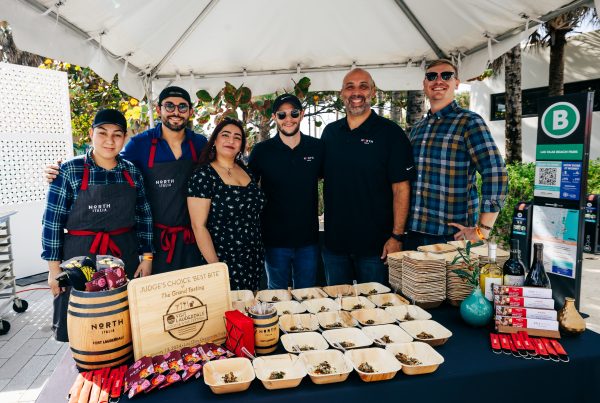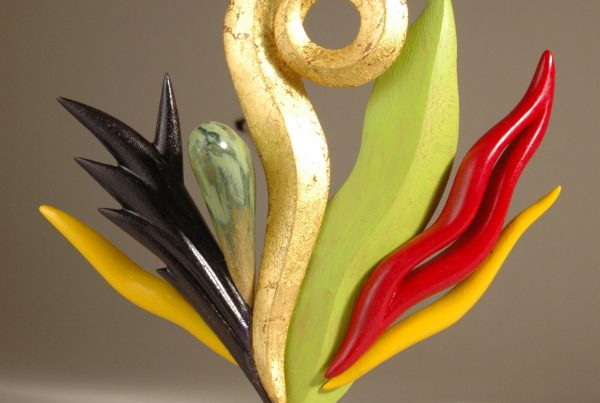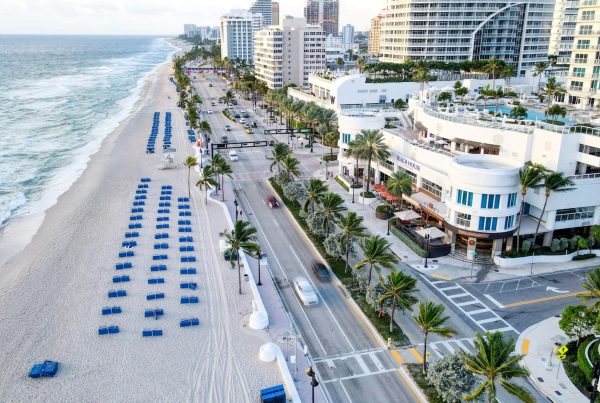The cliche “The journey is the destination” couldn’t have been truer from the ground level of Minca. On our itinerary for the day was to reach a coffee and cacao farm about 40 minutes up into the Sierra Nevada mountains, where we would tour the farm and try our hand at roasting coffee beans and tasting creamy dark chocolate.
The idea seemed easy enough—until our guide told us we needed to change into a vehicle that could handle the journey. After all, making your way up the mountain requires four-wheel drive to navigate the unpaved potholes and winding one-way roads. More than once, our truck came face-to-face with another car, and in a choreographed dance, the drivers nonchalantly drove off the road, oftentimes clinging to the side of the mountain to make way for the passing car.

They say to only be worried if the flight attendant looks worried; our driver was nonchalant (probably because he makes this trek multiple times a day, every day), so I followed his cue and instead looked out the window at a waterfall and cascading guadua bamboo trees, searching for capuchin and howler monkeys and jaguars (no luck). We passed intrepid hikers and motorcyclists, hostels and restaurants, then finally arrived at the top to Finca La Candelaria.
Looking out at the vistas of the Sierra Nevada, it’s the same view that the Tayrona people had centuries ago. It’s in these mountains that the ancient civilization created a metropolis, all in spite of the encroaching power of Spanish conquistadors and colonialism. Visitors to the region take on the challenge to visit Ciudad Perdida Teyuna, or the Lost City, the home of the Tayrona people and one of the oldest indigenous sites in the world. The four- to six-day trek, depending on your athleticism, weaves through the jungles of the Sierra Nevada before arriving at the ancient city.

This year, Santa Marta—about a 45-minute drive to Minca—is celebrating its 500th anniversary. Of course, that’s excluding the presence of the Tayrona, meaning “sons of the jaguar.” Historians believe they first arrived around 200 BCE, and their descendents—the Kogui, Arhuaco, Kankuamo and Wiwa—are a testament to the fortitude of the culture, numbering around 30,000 people.
During our time in northern Colombia, there was a magical melding of the past and the present, the survival of culture and tradition in the 21st century.
Caffeine Fix

Back at the farm, there’s a breathtaking vista of the misty mountains fading into the Caribbean Sea. All around us, we saw trees bursting with cacao and coffee pods; CDs were hanging from tree limbs to ward away birds; and fruits were strewn about to distract squirrels from the good stuff. The third-generation, family-owned farm grows three coffee varieties on the 28-hectare property—Colombian, Castillo and Cadura coffee—and produces 1 ton of cacao and 6 tons of dried coffee beans annually.

Not unlike a science teacher, our guide, Eduardo, shows us the life cycle of chocolate, beginning as a bean inside a large yellow pod, each bean wrapped in a sweet, white fleshy fruit. The beans are broken down into nibs, and then ground into a chocolate paste. I had a chance to grind the cacao beans—no easy task, turning the crank by hand—and the team then added milk and a dash of sugar to the mash to make hot chocolate. Having it straight from the bean was very bitter, and a wakeup call to how much sugar is added to make it a sweet treat.
It’s not just for drinking, though; customers also purchase cacao exfoliating face masks (honey is added, for this). A farm team member went around brushing the chocolate onto our faces; a French backpacker and I looked at each other laughing and taking selfies together for the memories.
For the coffee, I was put to work again with another visitor, essentially separating the shell from the beans in a giant wooden mortar and pestle. Eduardo made it look easy, of course, simultaneously smacking the pestle while turning it with the flick of his wrist. The collected beans went into the roaster and were then ground by hand once again for the freshest coffee you could imagine—picked straight from the tree.

Coffee is king in Colombia; the nation ranks fourth in the world for coffee production. For almost 100 years, the Federación de Cafeteros has served as a nationwide union for coffee growers. Coffee was easy to find, from the Amorigen espresso bar at the hotel to Juan Valdez stands around the city. While we were exploring “downtown” Santa Marta, a man in indigenous regalia was in line at a stand waiting for his cup to be prepared.
On the Town

We were walking through Bolívar Plaza when our guide joked that every city in Colombia has a Bolívar Plaza. Simón Bolívar is a Colombia hero who led the country to its independence from the Spanish empire. He served as the first president of Colombia (somehow he simultaneously served as president of Peru and Bolivia, nations he also freed from Spanish rule) and died in Santa Marta in 1830.
Adjacent to the square is the Museo del Oro Tairona, a branch of Bogota’s lauded gold museum that showcases more than 500 pieces of intricate work by pre-Columbian people. The exhibits of gold, pottery and stone are housed within the Casa de la Aduana, the customs building during the colonial period. In the center of the building is a courtyard with a beautiful dark wood wraparound patio surrounding a tree jutting into the sky. Another site of note is Catedral Basílica de Santa Marta, the oldest cathedral in all of Colombia as well as the first basilica in Latin America. While passing by on a Friday evening, mass was just getting started, and vendors outside were selling patron saint medals and rosaries.

In the evening, Santa Marta’s historic district comes alive with music, storefronts hawking wares, bustling hostels, and people out for a night on the town. Our group dined at Guasimo, the inside bursting with colorful oil paintings created by the chef, Fabian Rodriguez, and the sounds of two men singing along to a guitar and bongo. The walls are covered in a rotating collection of Rodriguez’s paintings, portraying the bright hues of Colombia’s birds, fruits, landscapes and people. After our eyes feasted on the artwork, it was our stomach’s turn to try his culinary masterpieces, a chef’s tasting menu. We were treated to flavors like steak topped with chimichurri, a salad with grilled tamarillo, and a dessert of fried cheese topped with mango and cream. I thought I knew all my tropical fruits until I got to Colombia.
Hospitality

At the end of each day during our time in Santa Marta, we returned to the refuge of the beachfront Santa Marta Marriott Resort Playa Dormida. Although it’s located on a public beach, it’s not bursting at the gills with swimmers like we’re used to in touristy South Florida. Families play in the sand, couples take a walk around the curve of the shore, and beneath the shade of a tree, vendors sell beaded jewelry, bags and clothing. That’s the view to the west, while to the east is a nature reserve; the hotel owns and protects part of it. The quiet of the reserve can be enjoyed from the Seishua spa’s relaxation deck or while soaking in a hot tub.
The hotel itself is a living nod to the region’s natural resource, from the raw-edge desks in each suite to the brass guacamaya (macaw) sculptures on the walls, and a guadua bamboo structure in the lobby’s great room that serves as a covered seating area. Throughout the space are items representative of the Tayrona descendants, such as gourds, bags and other textiles (most notably, a woven white cap worn by shamans). A floor-to-ceiling mural by Colombian artist Eloin Rivera is the centerpiece of the hotel, showcasing the icy mountaintops, green jungles, sandy beaches and azure ocean of Santa Marta, with the same golden guacamaya flying overhead.
From the deck of the 1525 Restaurant & Terrace are views of the ocean gently ebbing and flowing with the tide. A view that can’t be ignored, though, is the trupillo tree that grows in the alfresco Cayeye restaurant. We were told that the hotel proprietor is fond of Tayrona history and culture, so before construction, he brought a mamo, or indigenous spiritual leader, to bless the land. The mamo was drawn to the trupillo tree, which he said represented prosperity, and encouraged the hotel to build around it. This tree towers to the second-floor terrace and is perhaps in the background of countless visitors’ photos of impeccable sunset selfies.
Arts & Crafts

When our time in Santa Marta came to an end, we crossed the land bridge over to Barranquilla, a more metropolitan city and the fourth most populous in Colombia. While I waited to check into our hotel, the Barranquilla Marriott Hotel, I perused the small gift shop and found palm-woven accessories that would easily be featured in a “get ready with me” outfit curated by a Lilly Pulitzer and Free People lover. Luckily for us, we would see where it was all made.
The town of Usiacurí, a little over an hour away from Barranquilla, is known for its tradition of artisans hand-weaving threads of iraca palm into intricate designs for bags, coasters, fans and plate chargers. Sitting in her chair in an open stall, Lesvia Jimenez’s fingers seem to move independently from the rest of her body; she gives out prices and nods at items hanging from the walls as she weaves strings of iraca palm. It takes her just minutes to make a napkin ring in the shape of a hibiscus flower, and I think about how much it would probably fetch back in the U.S. At almost 80 years old, her hands have been weaving since she was 5; it’s a skill she learned from her mother, who learned from her own mother. Jimenez has taught the next generation how to weave iraca handcrafts, and she employs 30 to 40 families to create pieces for the business.


Art is quite literally a part of Usiacurí. We’re taken to Iglesia Santo Domingo de Guzmán, a blue-roofed church with an enormous painting of Jesus Christ spread over its 30 steps leading to its front doors. From this vantage point, one can see a living mural spread over the metal roofs of countless homes. It’s 10,700 square feet of murals, to be exact, using Pintuco paints (a local paint company) and following the theme of birds—the eyes of an owl, an emerald green parrot, and the wings of a parrot dot the green landscape. On one roof, the artist Ospen tags his name, taking ownership of his oversized masterpiece.
My time in northern Colombia was a whirlwind, traipsing from one adventure to the next. As I carefully packed my bag—bags of coffee beans, an iraca palm purse, and an SD card filled with photos—I was bringing pieces of Colombian tradition and artisanship home with me.
This story is from the April 2025 issue of Boca magazine. For more like this, click here to subscribe to the magazine.







